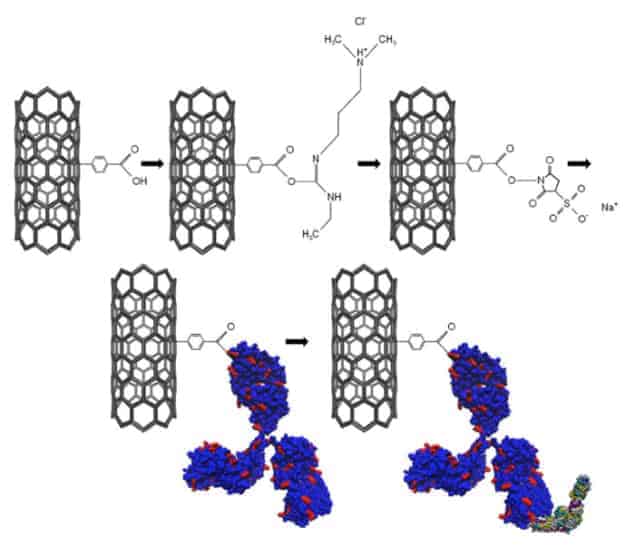
Researchers in the US have made a new biosensor from carbon-nanotube transistors that is capable of rapidly detecting the antigens of Lyme disease. The device can detect the biomarkers at concentrations as low as 1 ng/ml, which is better than is possible with standard urine testing and comparable to traditional ELISA and Western-blot immunoassays.
Lyme disease occurs throughout much of the northern hemisphere and is spread by ticks carrying the Borrelia burgdorferi bacterium. At least 30,000 new cases are reported in the US alone each year. The disease often goes unchecked – especially in its early stages – because the symptoms are so non-specific and because of a lack of sensitive tests. Late detection can be dangerous, however, because the disease can cause arthritis and even permanent neurological disorders, among other health problems.
Now, a team led by A T Charlie Johnson of the University of Pennsylvania has made a new Lyme-disease biosensor from large arrays of semiconducting carbon nanotube (CNT) transistors grown by chemical vapour deposition on oxidized silicon wafers. “Using a covalent-chemistry technique developed in our lab, we are able to attach antibody proteins to the nanotubes very efficiently,” explains Johnson. “These antibodies have a high affinity for the antigen protein of interest – p42 flagellar – which is a protein from the flagellum of the bacterium that carries Lyme disease. If this Lyme antigen is present in a sample, it gets captured by the antibodies, something which induces a change in the electronic properties of the nanotube transistors.”
The Pennsylvania group’s work follows on from similar strategies to detect prostrate-cancer biomarkers using CNTs. Indeed, the researchers say that they may one day be able to detect any disease with such nanotube devices simply by coating them with the appropriate proteins.
Close to nanotubes
“By directly attaching such antibody proteins to CNT transistors, the Lyme antigen is captured very close to the nanotubes,” says Johnson. “Since antigens are charged molecules, bringing them into the immediate vicinity of the tubes will alter the transistors’ electronic properties in a concentration-dependent manner – with higher antigen protein concentrations binding more antibodies. By measuring the shifts in these properties we can deduce the exact concentration of the Lyme antigen in a sample.”
The device can currently detect concentrations of the Lyme antigen as low as 1 ng/mL, which is better than is possible using urine tests (15 ng/mL) and comparable to traditional ELISA and Western-blot immunoassays. However, there is more to disease diagnosis than just sensitivity, says Johnson.
“The Centers for Disease Control and Prevention currently recommends a two-tiered testing approach for Lyme disease,” he explains. “The first tier is an ELISA assay, but this test can produce a false negative if the patient has a disease similar to Lyme. More importantly, it cannot distinguish between Lyme antibodies caused by a current, active Lyme infection and those caused by past, treated infections.”
The second-tier test is a Western blot, which tests specifically for Borrelia burgdorferi. Using Western blot on its own is more likely to lead to a false positive, resulting in inaccurate diagnosis and unnecessary treatment for a patient whose true disease may continue to afflict them.
“Our protein–nanotube hybrids overcome both these problems because they look directly for Lyme antibodies. This means that there is no lag between infection and detection (as in ELISA), and no danger of confusing current and past infections because the antigens will only be present if the Borrelia is active,” says Johnson.
Further improving the detection limit
The team says that it could further improve the detection limit of its sensor by attaching only the piece of the antibody (known as a “fragment”) responsible for antigen binding instead of the whole antibody protein. This would allow the antigens to be captured even closer to the nanotubes, which, in turn, would increase sensitivity – possibly by several orders of magnitude.
There is still much work to be done before the technology becomes commercially available; however, Johnson says that, luckily, there are several organizations that are already “very interested” in the group’s research. “An important next step is to develop methods to detect Lyme antigens in complicated real-word samples, such as human blood. Subsequent steps will include animal and, finally, human clinical trials.”
The attachment chemistry exploited in the new sensor relies on common protein features, so it could easily be extended to detect several biomarker proteins simultaneously, says Johnson. “For example, VIsE and OspA are other proteins from Borrelia burgdorferi that have been implicated in Lyme disease, so we could think about expanding our search by attaching antibodies for those antigen proteins to our nanotube transistors,” he adds. “Taking it one step further, we could even include proteins for other diseases on the same chip (nanotubes are quite small after all) and perform tests for all kinds of maladies using a single, small-volume blood sample. Someday, a medical check-up might consist of simply dropping blood on a nanotube array functionalized with hundreds or even thousands of different proteins, each looking for things as diverse as heart disease, arthritis, Alzheimer’s or stress biomarkers, with the results available in seconds – and all at very little cost.”
The research is described in Biosensors and Bioelectronics.



